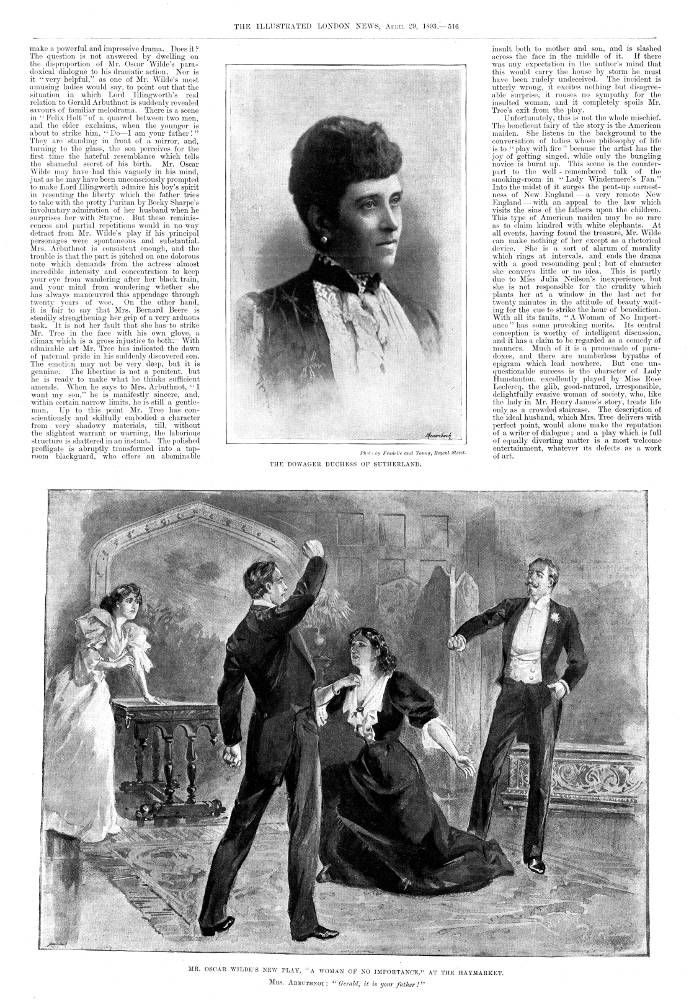
© Mary Evans Picture Library. Click on image to enlarge it.
A photograph of the Dowager Duchess of Sutherland appears immediately above a drawing of A Woman of No Importance in The Illustrated London News of April 29, 1893 (p. 516). This might be unremarkable, other than that all of the text alongside the photograph is about the play, which premiered the evening she went to jail. As I shall show, the placement of this photograph was hardly a coincidence.
We know that Wilde had connections with the Duke of Sutherland’s family: Lord Ronald Gower (The Picture of Dorian Gray) was the Duke’s brother (Rose 47), and one of Wilde’s favoured women was Constance, the Duchess of Westminster, the Duke’s sister (Fitzsimons). There is a further connection of Wilde with the Sutherland circle. Edward Carson was a guest on the Duke of Sutherland’s steam yacht in 1886 until, according to family lore, the Duke made him leave when they reached the Azores (Layton, 135-36) because he had flirted with Mary (“May”) Caroline Blair, a widow who had been the Duke’s lover since at least 1882. She brought Carson back into her life eight years later, nine months before Wilde’s trial.
Mrs. Blair and the Duke married so soon after the death of his first Duchess that many aristocrats, and, more importantly, Queen Victoria, were outraged by what they took to be a scandalous offense against propriety. In fact, Mrs. Blair’s ostracism began late in 1887, when the Duke insisted that she stay at his side when he was thought to be dying. Although the Duke and Duchess had long been estranged, Mrs. Blair’s (and it was seen as Mrs. Blair’s) offense against propriety was unforgivable.
The Duke died in 1892, his second marriage dogged by his children’s trenchant opposition and multiple legal skirmishes. These turned into a war over the Duke’s latest will, which was made entirely in his new wife’s favour. She, one of her brothers, and the Duke’s long-standing friend, Lord Dufferin, were the executors. The 4th Duke denied them access to the desk holding the 3rd Duke’s private papers. When the court ordered the desk opened in the adversaries’ presence, the Dowager Duchess astounded everyone by throwing a mystery document into the fire, which her detractors thought proof of her liaison with the Duke, and she spent six weeks jailed in Holloway for contempt of court. The press had a field day. She lost several more legal battles, possibly because of Queen Victoria’s widely publicised views and their impact on a weak bench.
Given that the Prince of Wales had been called as a witness, it was widely believed that the scheduled 1894 hearing was going to reveal salacious details that would provide the scandal of the decade. Everyone expected the Dowager Duchess to lose the vast fortune the Duke had left to her, but this was not quite how it turned out.
Two days before the challenge was to be heard, the Dowager Duchess added Edward Carson to her legal team. No sooner had the President of the Probate Court seated himself than Carson asked him for a few minutes with counsels. The minutes dragged on, and, after nearly an hour, they emerged saying they had come to an arrangement. The Dowager Duchess made various concessions and received a substantial sum, albeit less than the Duke had intended. According to family lore, Carson emerged from a cross-examination saying “What a woman!” Because there was no such examination (family lore tends to distort information over time), her performance must have been behind the scenes.
The Dowager Duchess’s apparent solution to her court dilemma closely resembles the plot of An Ideal Husband (Layton 274-76). The three letters around which the plot revolves include (1) insider trading and the purchase of the Suez Canal, (2) a burnt note, and (3) a third note that could be construed as amorous. In the Dowager Duchess’s case, (1) the Duke was present in Egypt when the Suez was sold and had investments there, (2) the burned document could have concerned the debacle at the Azores, and (3) Duchess Anne used to flirt harmlessly with the Prince of Wales. The Dowager Duchess had letters from the Duke that likely mentioned this; her 1887 diary, in family hands, has the pair corresponding daily when apart. (Her annotated diary is reproduced and discussed in Layton, chapters 16 and 17.)
If the Dowager Duchess acted like Mrs. Cheveley to save herself and her daughter from ruin by having Carson confirm her story, then the question becomes whether life imitated art or vice versa.
References
Fitzsimons, Eleanor, Wilde’s Women: How Oscar Wilde was Shaped by the Women he Knew. London: Bloomsbury Publishing, 2016. [e-book]
Layton, Catherine. The Life and Times of Mary, Dowager Duchess of Sutherland: Power Play. Newcastle: Cambridge Scholars Publishing, 2018. Web. [Online here].
Rose, David C. “Oscar Wilde: Socialite or Socialist?” In Uwe Böker, Richard Corballis, and Julie A. Hibbard, The Importance of Reinventing Oscar: Versions of Wilde During the Last 100 Years. Amsterdam: Rodopi, 2002: 47.
Last modified 28 March 2018